SCOTLAND
Society

Society
Cities in SCOTLAND
| Edinburgh | Glasgow |
Popular destinations UNITED KINGDOM
| England | Northern ireland | Scotland |
| Wales |
Society
Government
Scotland belongs to the United Kingdom of Great Britain and Northern Ireland, a constitutional monarchy headed by Queen Elizabeth II since 1952.
Scotland had formed a parliamentary union with England since 1707 ("Act of the Union"), but it maintained its own legal system. In the British cabinet, one minister, the Secretary of State for Scotland, is in charge of Scottish affairs. He heads the government center in Edinburgh (St. Andrew's House). This Scottish Office also has an office in London under the same name. The Secretary of State is directly accountable to Parliament for the actions of the departments that make up the Scottish Office.
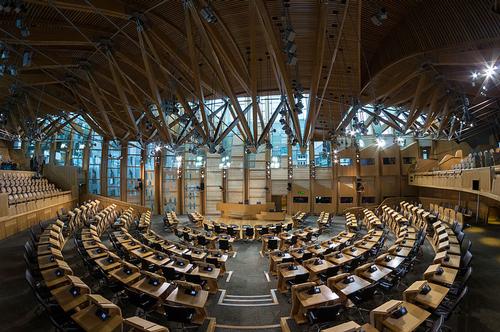 Debating chamber of the Scottish ParliamentPhoto: Colin CC 4.0 Internationaal no changes made
Debating chamber of the Scottish ParliamentPhoto: Colin CC 4.0 Internationaal no changes made
The Blair government decentralized regional affairs, giving Scotland its own parliament for the first time in three centuries. Before that, a referendum was first held in 1997, with 74.3% voting for the formation of their own Scottish Parliament. Then, in May 1999, a parliament was elected for the first time in 300 years, which first met in January 2000.
The first First Minister of Scotland became Glasgow socialist Donald Dewar. It was striking that 48 women were elected in the 129-member parliament. Only the parliaments of Denmark and Sweden have a higher percentage of women in their ranks.
Important powers of the new parliament are the introduction of laws and certain powers in taxes. Furthermore, decisions are taken on matters such as health care, education, housing and agriculture. The Scottish Development Department has overall responsibility for local government.
Scotland has no president and is simply part of the United Kingdom, so the Queen is still officially the head of the state. For the current political situation see chapter history.
Administrative division
Since 1975 Scotland has been administratively divided into nine regions, divided into 53 districts, and three independent administrative units (so-called Island Authorities) for the administration of the Orkney Islands, Shetland Islands and Western Isles. In 1996 a new reclassification took place, in which 32 administrative units replaced the nine 'regions' and 53 districts.
| Area | Main city | Population | Area |
| Aberdeen City | Aberdeen | 212.000 | 186 km2 |
| Aberdeenshire | Aberdeen | 226.000 | 6.313 km2 |
| Angus | Forfar | 108.000 | 2.182 km2 |
| Argyll and Bute | Lochgilphead | 91.000 | 6.909 km2 |
| City of Edinburgh | Edinburgh | 450.000 | 264 km2 |
| Clackmannanshire | Alloa | 48.000 | 159 km2 |
| Dumfries and Galloway | Dumfries | 148.000 | 6.426 km2 |
| Dundee City | Dundee | 146.000 | 60 km2 |
| East Ayrshire | Kilmarnock | 120.000 | 1.262 km2 |
| East Dumbartonshire | Kirkintilloch | 108.000 | 175 km2 |
| East Lothian | Haddington | 90.000 | 679 km2 |
| East Renfrewshire | Giffnock | 90.000 | 174 km2 |
| Eilean Siar | Western Steòrnabhagh | 27.000 | 3.071 km2 |
| (Isles) | |||
| Falkirk | Falkirk | 145.000 | 297 km2 |
| Fife | Glenrothes | 350.000 | 1.325 km2 |
| Glasgow City | Glasgow | 603.000 | 175 km2 |
| Highland | Inverness | 210.000 | 25.659 km2 |
| Inverclyde | Greenock | 84.000 | 160 km2 |
| Midlothian | Dalkeith | 81.000 | 354 km2 |
| Moray | Elgin | 87.000 | 2.238 km2 |
| North Ayrshire | Irvine | 135.000 | 885 km2 |
| North Lanarkshire | Motherwell | 320.000 | 470 km2 |
| Orkney Islands | Kirkwall | 20.000 | 990 km2 |
| Perth and Kinross | Perth | 135.000 | 5.286 km2 |
| Renfrewshire | Paisley | 173.000 | 261 km2 |
| Scottish Borders | Newtown St. Boswells | 107.000 | 4.732 km2 |
| Shetland Islands | Lerwick | 22.000 | 1.466 km2 |
| South Ayrshire | Ayr | 112.000 | 1.222 km2 |
| South Lanarkshire | Hamilton | 302.000 | 1.772 km2 |
| Stirling | Stirling | 86.000 | 2.187 km2 |
| West Dumbartonshire | Dumbarton | 93.000 | 159 km2 |
| West Lothian | Livingston | 160.000 | 427 km2 |
Education
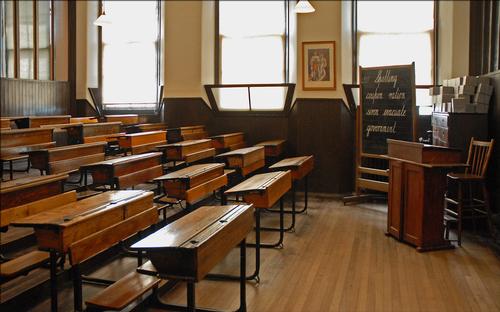 Scotland Street School Museum (Glasgow)Photo: Jean-Pierre Dalbera (CC BY 2.0) no changes made
Scotland Street School Museum (Glasgow)Photo: Jean-Pierre Dalbera (CC BY 2.0) no changes made
Nursery education
Early childhood education (ages 2 to 5) is provided, usually free of charge, by central government, local government and private institutions. The government is expanding the educational options for the youngest children. Places will be offered at subsidized schools and nursery classes for all four-year-olds whose parents wish.
Primary education
Compulsory education in Scotland is divided into primary education (ages 5 to 12) and secondary education (ages 12 to 16). Primary school normally starts at the age of five and lasts seven years. This period includes three stages: P1 to P3 (early education stage), P4 and P5 (middle stage) and P6 and P7 (upper primary stage).
Education during the compulsory school age is free and the educational authorities provide the necessary educational facilities.
All students learn a foreign language during the last two years of primary education. In some schools, Gaelic is taught as a second language or used as a language of instruction. No certificate is issued at the end of primary education.
Lower secondary education
Lower secondary education is provided to comprehensive schools, which offer a mandatory four-year polyvalent training. The lower secondary education consists of two stages: after two years of general education (S1 and S2), two years (S3 and S4) follow specialized and vocational education for all students.
In addition to English, all students learn at least one other language, preferably a living European language, during the four years of compulsory secondary education.
No certificate is issued at the end of primary education. At the end of compulsory education, students take an external exam, drawn up by the Scottish Examination Board. They will receive a certificate stating the grade for each subject (from 1 to 7). Students may also obtain the Scottish Vocational Education Council (SCOTVEC) National Certificate and participate in short Scottish Examination Board courses.
Higher secondary education
Upper secondary education is offered in the last two years (S5 and S6) of the secondary school. In those last two years, students in S5 and S6 can take many courses and combine Scottish Certificate of Education (SCE) Higher Grades and, in S6, Certificate of Sixth Year Studies (CSYS) with short courses from the SCE and / or modules of the SCOTVEC National Certificate.
It is common for students to take as many as five SCE Higher Grade exams in a year and thus maintain a broad, balanced program. Universities often require students to have completed Higher Grades. In Scotland, secondary schools are free, as are the Further Education Colleges for students who are 18 years old on September 1 of the enrollment year.
Higher education
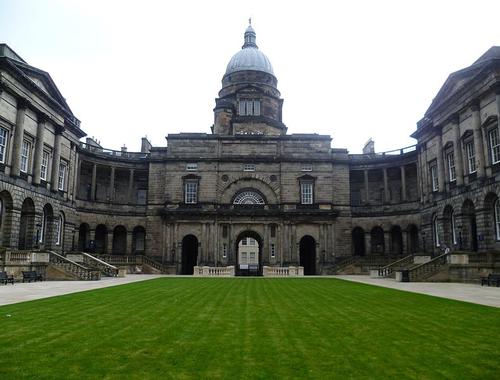 Old College of Edinburgh UniversityPhoto: Kim Traynor CC 3.0 Unported no changes made
Old College of Edinburgh UniversityPhoto: Kim Traynor CC 3.0 Unported no changes made
Since 1992, almost all higher education institutions belong to the same category. Each university is autonomous and decides itself on "degrees" (degrees) and other titles that it issues and also sets its own standards. Most universities have a wide spectrum of university and post-university courses. University vocational courses are generally offered by polytechnic universities.
To be admitted to higher education, students must have passed a number of Standard-Grade or Higher-Grade exam subjects organized by the Scottish Examination Board for the purpose of issuing a Scottish Certificate of Education.
The Ordinary Degree concludes three years of full-time study; the Honors Degree completes a more specialized and usually tougher four-year course. The first degree in arts, humanities and languages (Master of Arts - MA) from Scottish universities has been equated with the Bachelor's degree from England. More and more institutions are awarding a Bachelor's degree, especially to engineers and teachers.
Postgraduate studies are completed with postgraduate degrees after one year, or with a Master's degree after two years. Research degrees (MPhil, PhD) can be obtained at almost any higher education institution.
There are 12 universities in Scotland: Aberdeen (founded 1495), Dundee (1960), Edinburgh (1582), Glasgow (1451), Heriot-Watt (Edinburgh, 1966), St Andrews (1411), Stirling (1964), Strathclyde (Glasgow, 1963) and four polytechnic schools that received university status in 1992.
Typically Scottish
MUNROS
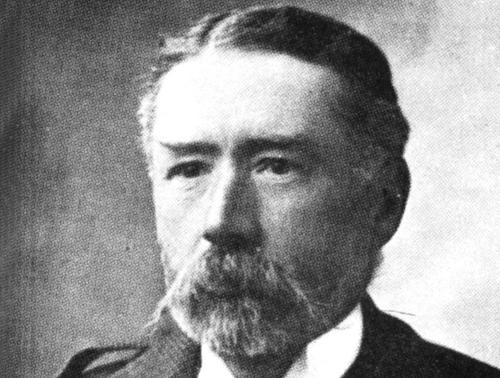 Sir Hugh Munro ScotlandPhoto: Alistair Munro in the public domain
Sir Hugh Munro ScotlandPhoto: Alistair Munro in the public domain
A "Munro" is a mountain in Scotland over 3000 feet or 914 meters high. The name Munro refers to Sir Hugh Munro, the first president of the Scottish Mountaineering Club (SMC), who established a list of 277 munros in 1891.
The exact number of Munros is still not fixed after all these years and changes with every new count. The big problem is: when is it an independent top and when is it part of another Munro. It is nowadays generally agreed that there are at least 284 Munros.
In the 1920s, J. Rooke Corbett published a list of mountain peaks between 760 and 915 meters. These 221 "Corbetts" are more clearly defined than the Munros, because they can only have one top.
Mountain peaks of 610-760 meters are called "Grahams" and are on a third list. All peaks higher than 610 meters are now categorized and published.
MONSTER OF LOCH NESS
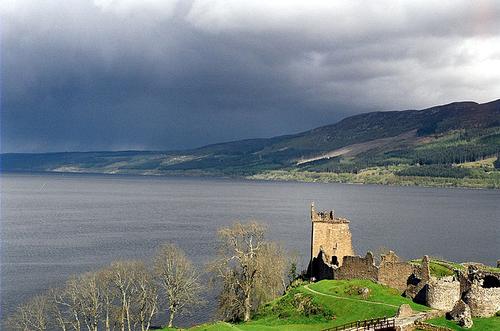 Loch Ness ScotlandPhoto: Sam Fentress CC 2.0 Generic no changes made
Loch Ness ScotlandPhoto: Sam Fentress CC 2.0 Generic no changes made
When the most famous monster in the world is "spotted" for the first time remains uncertain. An international phenomenon became "Nessie" only in the thirties of the last century.
In May 1933, the Inverness Courier reported a couple who saw a strange beast swimming around Loch Ness, Britain's deepest freshwater lake.
Soon more people appeared to have "seen" the monster and the myth was born, which continues to date. Books have been published and Inverness tourism has flourished. As yet, no hard evidence has been found and it only seems important for the local middle class to maintain the myth.
Loch Ness, 37 kilometers long and about 1.5 kilometers wide, is 213 meters deep almost everywhere, except for one part, where the saline bottom is located at 305 meters. The Loch is fed by eight rivers and about 40 streams.
WHISKY
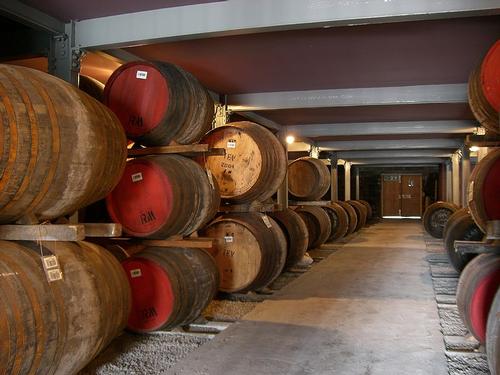 Whiskey Barrels ScotlandPhoto: Chistian CC 2.0 Generic no changes made
Whiskey Barrels ScotlandPhoto: Chistian CC 2.0 Generic no changes made
The earliest known reference to whisky (Celtic: uisge beatha) dates from 1494. Whisky is one of Scotland's major exports and is even among the top five British exports. Numerous distilleries are scattered all over Scotland. More than 40 distilleries are already located in the village of Moray. Hundreds of millions of bottles are exported every year, mainly to the United States, France, Japan and Spain.
Whisky is made from barley, water and yeast. There are two types: malt whisky and grain whisky. Malt whisky is made from malted barley, grain whisky from malted barley, and another grain, usually corn. A "single malt" is a real malt whisky, while a "blend" is a mixture of malt whisky and grain whisky (40-60%).
TARTAN
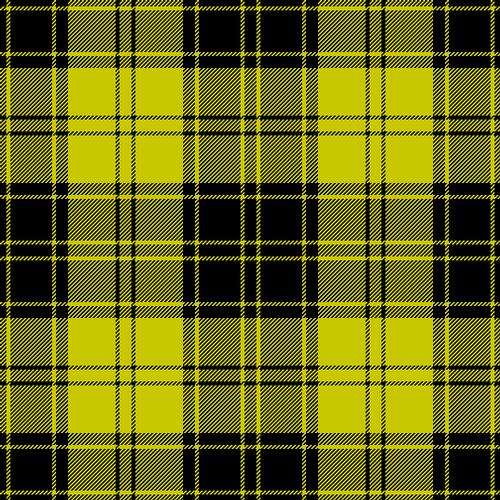 MacLachlan Tartan ScotlandPhoto: Celtus CC 2.5 Generic no changes made
MacLachlan Tartan ScotlandPhoto: Celtus CC 2.5 Generic no changes made
The Celtic word tartan means cover or jacket. The precursors of the tartan were used by the Celts two thousand years ago. The number of colors used increased with the place in the hierarchy: seven colors for the king, six for the Druids (the priests), and six for the nobles Nowadays the word tartan primarily means the colors and motif, the Scottish window, of the kilt material. The windows were the mark of the old clans.
In 1746, after the Battle of Culloden, the English Parliament banned the wearing of tartans, and many family colors were lost. Only the models that were recorded in old portraits are still considered authentic. All other clans had to have new tartans made, and at the moment there are about 1300 different designs of the tartans.
The tartans are divided into different groups such as 'chief tartans' for the clan chiefs and their immediate family, 'military tartans' for the Scottish regiments, the 'district tartans' for non-clan Scots and the 'royal tartans', exclusively reserved for the royal family. Since the sixteenth century, each region in the Scottish Highlands had its own diamond pattern.
CLAN
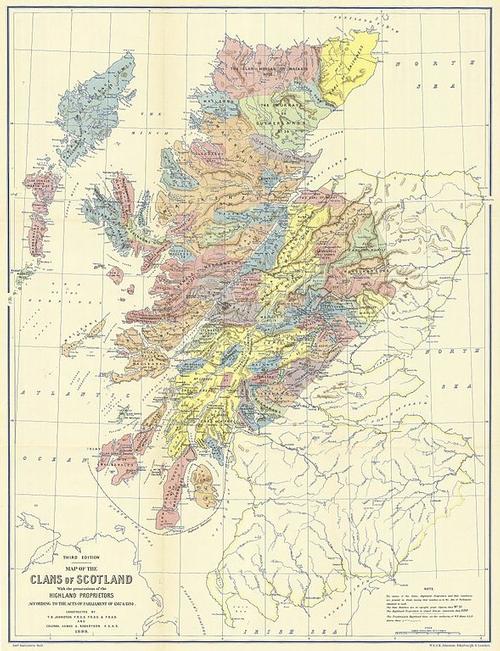 Map Clans of ScotlandPhoto: Public domain
Map Clans of ScotlandPhoto: Public domain
The Gaelic word "clann" means something like "children" or "family", but the clan included all who recognized the authority of the clan chief. The highland clans certainly formed complete patriarchal tribes with a clan chief or chief and a very large group of members until 1746, after the defeat at the Battle of Culloden. After the Battle of Culloden, all clan areas fell to the English Crown and the wearing of tartans was prohibited for nearly 100 years.
The clans ruled large areas and bloody mutual disputes were common. Nevertheless, the boundaries of the individual clans were generally maintained for centuries, including their own case law and their own traditional tartan (see above).
Although they only exist in name, the clans are still a source of pride for the Scots, and many people still live in their traditional clan territory.
KILT
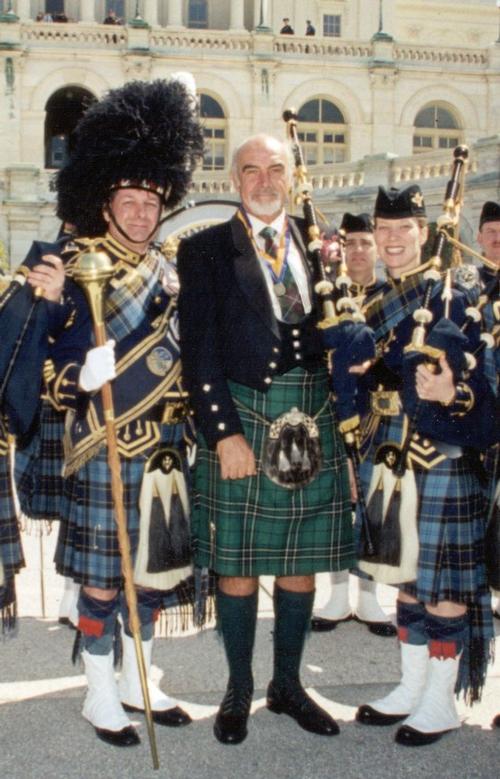 Sean Connery in KiltPhoto: Public domain
Sean Connery in KiltPhoto: Public domain
At the end of the 16th century the highlanders started to use the "breacan feile" or folded plaid. This plaid blanket, wearable by men only, is pleated around the waist and held by a belt. The dimensions are decent, 4.5 by 1.5 meters. The bottom part is the kilt, the top part is tied to the left shoulder with a cloth pin or brooch.
The breacan feile was the everyday clothing for the average highlander. The upper classes preferred to wear tight-fitting trousers, the "triubhas".
Around 1800 the smaller 'feile beag' or 'phillibeg' emerged from the large and somewhat clumsy kilt rug. This kilt is worn together with a leather bag ("sporran"), a beret ("balmoral"), a small knife in the stocking ("skean dhu") and artfully laced kilt shoes.
BAGPIPE
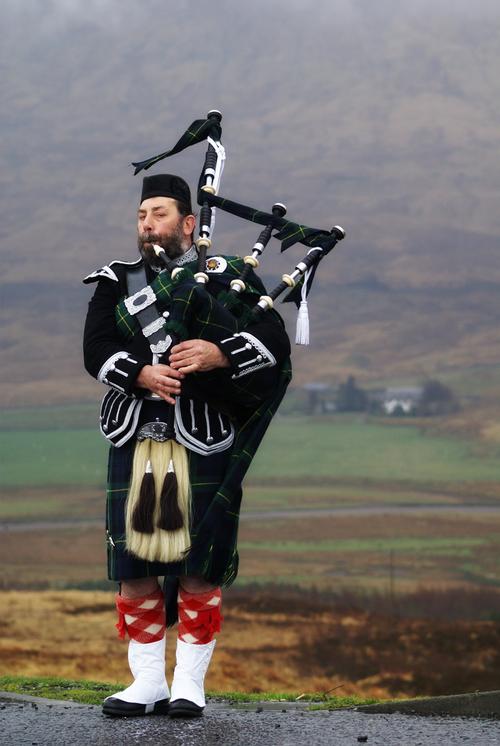 Bagpipe Player ScotlandPhoto: Gryphius CC 2.0 Generic no changes made
Bagpipe Player ScotlandPhoto: Gryphius CC 2.0 Generic no changes made
The bagpipe or "highland pipes", the national instrument, was probably originally used in the Highlands to transmit messages over long distances. Later, the reed instrument was used for marching music when the regiments of the Highlanders went to war.
The bagpipe bag is an inflatable bellows made of sheepskin, which, clamped under the arm, pressures an airflow into four pipes. The sound is created by the vibration of a picture in the pipe. The bagpipe player blows up the bag through a reed and plays on the melody pipe, the "chanter", a flute-like pipe made of hardwood. This pipe can produce nine tones, while the other three pipes ("drones") provide the accompaniment. The two tenor pipes sound an octave lower than the "a" of the "chanter", the bass pipe an octave lower than the tenor pipes.
According to the Royal Scottish Pipe Band Association (RSPBA), there are now over 400 bagpipe bands in the UK alone and hundreds more in all parts of the world.
The bagpipe music is typically Scottish and can be divided into two major groups: the 'ceol mor', great music specially written for bagpipes, and the 'ceol beag', light music inspired by marches and folk dances (branles' and 'reels').
Sources
Berkien, G. / Schotland
Kosmos-Z&K
Berkien, G. / Schotland
ANWB
Larrimore, D. / Schotland
Kosmos-Z&K
Levy, P. / Scotland
Marshall Cavendish
Patitz, A. / Schotland
Van Reemst
Schaff, B. / Schotland
Kok Lyra
Schotland
Cambium
Schotland
Lannoo
Schotland
Michelin Reisuitgaven
Schotland
Van Reemst
Smallman, T. / Scotland
Lonely Planet
Stoks, F.T. / Schotland
Gottmer
Summers, G. / Schotland
Van Reemst
Tschirner, S. / Schotland
ANWB
Wamel, D. van / Schotland en Noord-Engeland
Babylon-De Geus
CIA - World Factbook
BBC - Country Profiles
Last updated December 2025Copyright: Team The World of Info